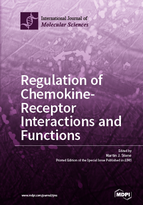Regulation of Chemokine-Receptor Interactions and Functions
A special issue of International Journal of Molecular Sciences (ISSN 1422-0067). This special issue belongs to the section "Molecular Pathology, Diagnostics, and Therapeutics".
Deadline for manuscript submissions: closed (31 July 2017) | Viewed by 83985
Special Issue Editor
Special Issue Information
Dear Colleagues,
A hallmark feature of inflammation is the accumulation of leukocytes, which can serve to remove pathogens and necrotic tissue, but may also damage healthy tissue and exacerbate the inflammatory response. Our understanding of leukocyte recruitment in inflammation was revolutionized in the late 1980s by the discovery of chemokines (chemotactic cytokines), a family of small, secreted proteins that induce migration of selective subsets of leukocytes. Shortly afterwards, chemokines were found to exert their functions through the now familiar chemokine receptors, members of the G protein-coupled receptor (GPCR) superfamily. As their physiological and pathological functions were elucidated, chemokine receptors have become popular targets for drug development in inflammatory diseases, as well as cancer metastasis and HIV infection. Extensive research has revealed that the functions of chemokines and their receptors are regulated at numerous levels, including: genetic mutations/polymorphisms; control of expression levels; ligand internalization via functional or decoy receptors; intrinsic selectivity of chemokine-receptor binding; hetero- or homo-oligomerization of chemokines or of receptors; alternative signaling pathways; interaction of chemokines with glycosaminoglycans (GAGs); post-translational modifications; and binding to pathogen-derived inhibitors. This Special Issue of IJMS focuses on the natural and pharmacological mechanisms by which the activities of chemokines and their receptors can be regulated.
Assoc. Prof. Dr. Martin J. Stone
Guest Editor
Manuscript Submission Information
Manuscripts should be submitted online at www.mdpi.com by registering and logging in to this website. Once you are registered, click here to go to the submission form. Manuscripts can be submitted until the deadline. All submissions that pass pre-check are peer-reviewed. Accepted papers will be published continuously in the journal (as soon as accepted) and will be listed together on the special issue website. Research articles, review articles as well as short communications are invited. For planned papers, a title and short abstract (about 100 words) can be sent to the Editorial Office for announcement on this website.
Submitted manuscripts should not have been published previously, nor be under consideration for publication elsewhere (except conference proceedings papers). All manuscripts are thoroughly refereed through a single-blind peer-review process. A guide for authors and other relevant information for submission of manuscripts is available on the Instructions for Authors page. International Journal of Molecular Sciences is an international peer-reviewed open access semimonthly journal published by MDPI.
Please visit the Instructions for Authors page before submitting a manuscript. There is an Article Processing Charge (APC) for publication in this open access journal. For details about the APC please see here. Submitted papers should be well formatted and use good English. Authors may use MDPI's English editing service prior to publication or during author revisions.
Keywords
- Chemokine
- Chemokine receptor
- Regulation
- Polymorphism
- Decoy receptor
- Oligomer
- Signaling pathway
- GAG
- Post-translational modification
- Inhibition







